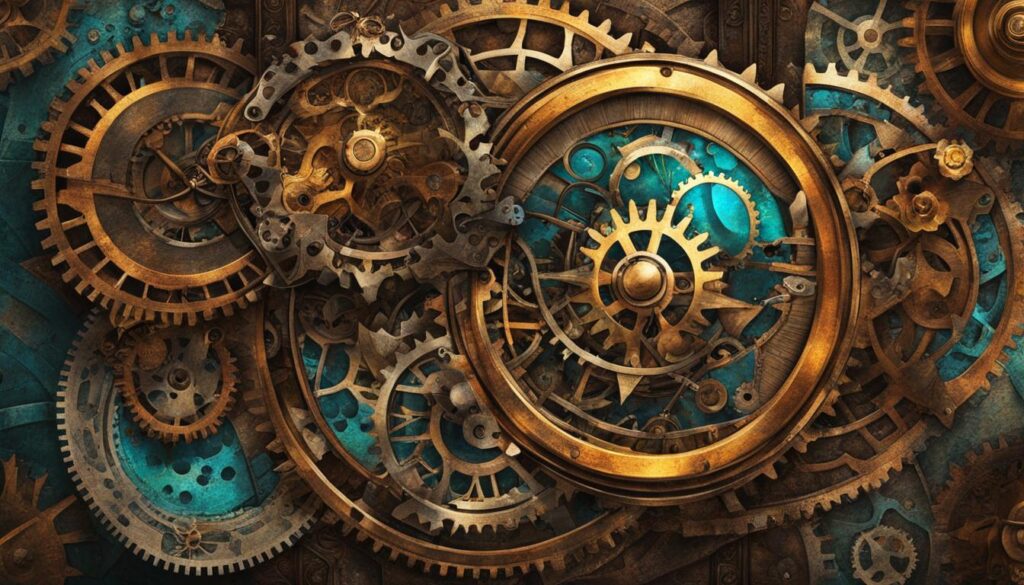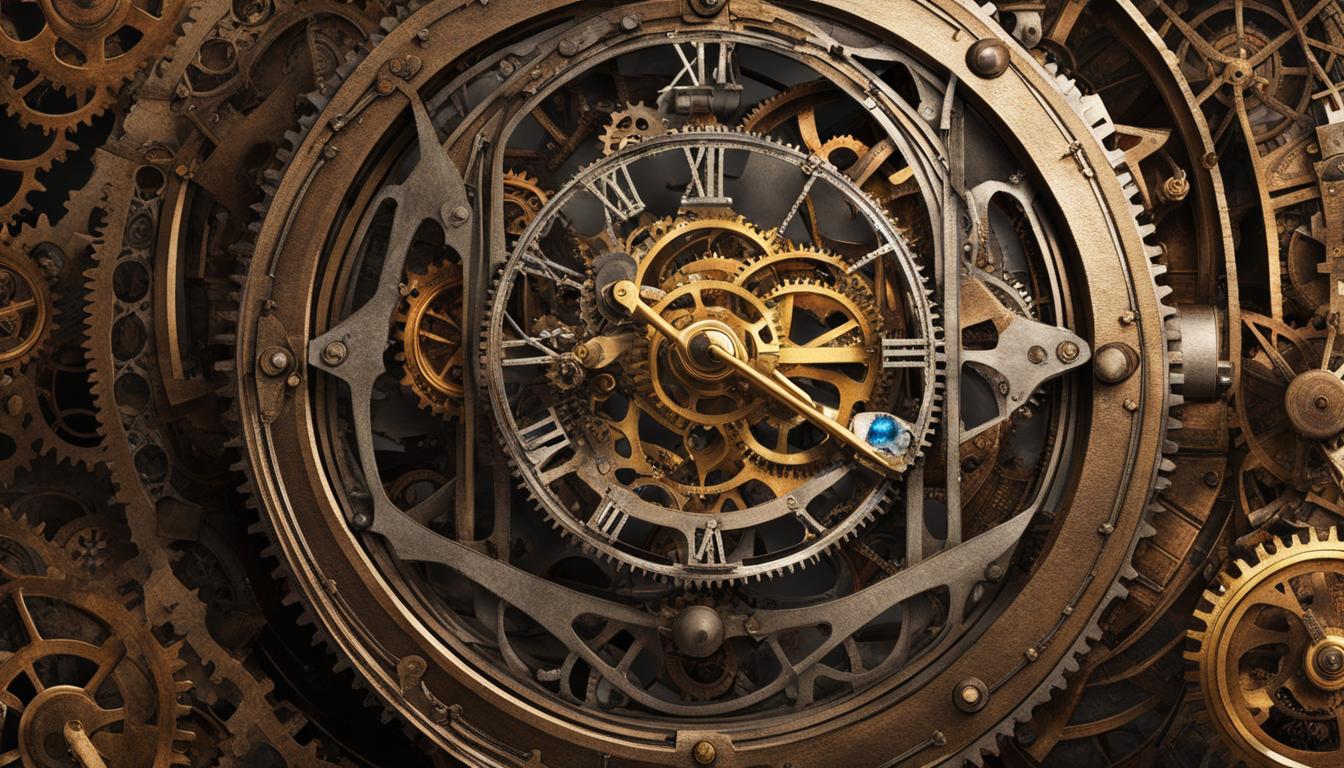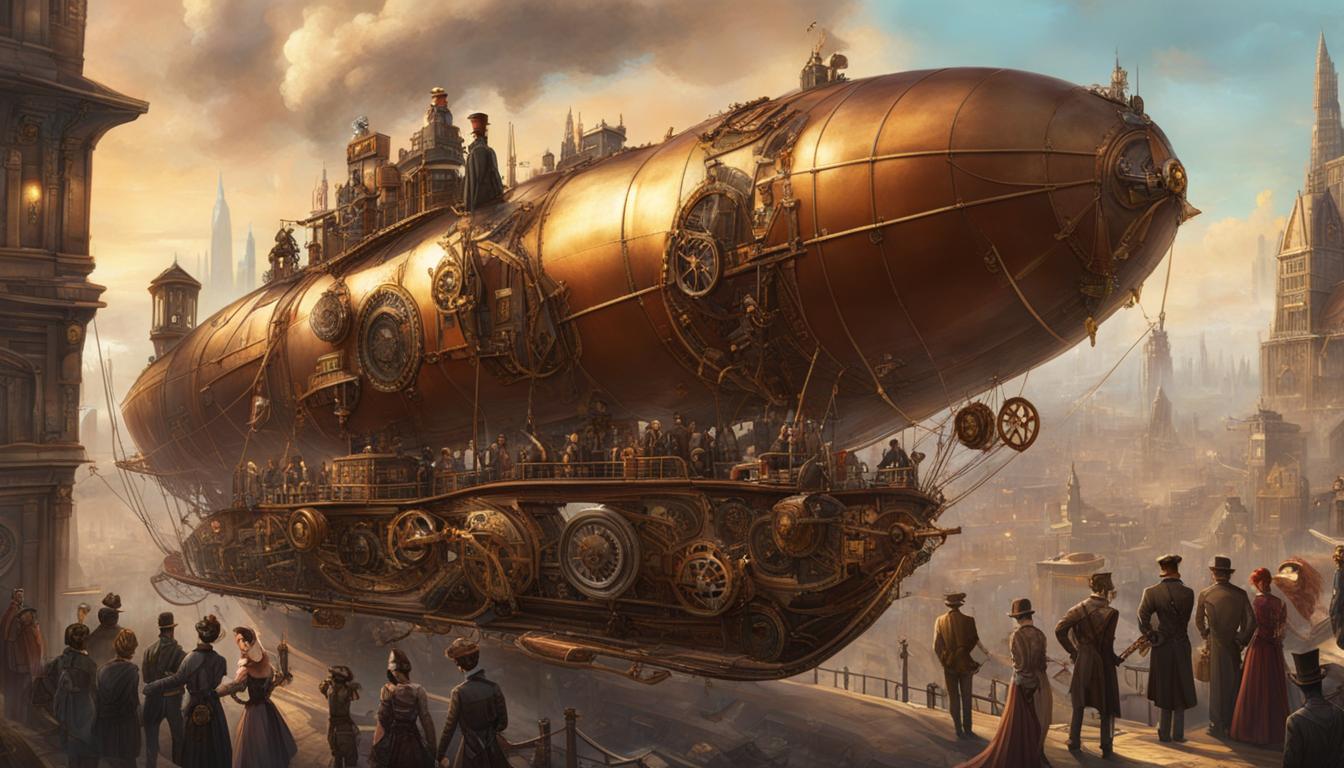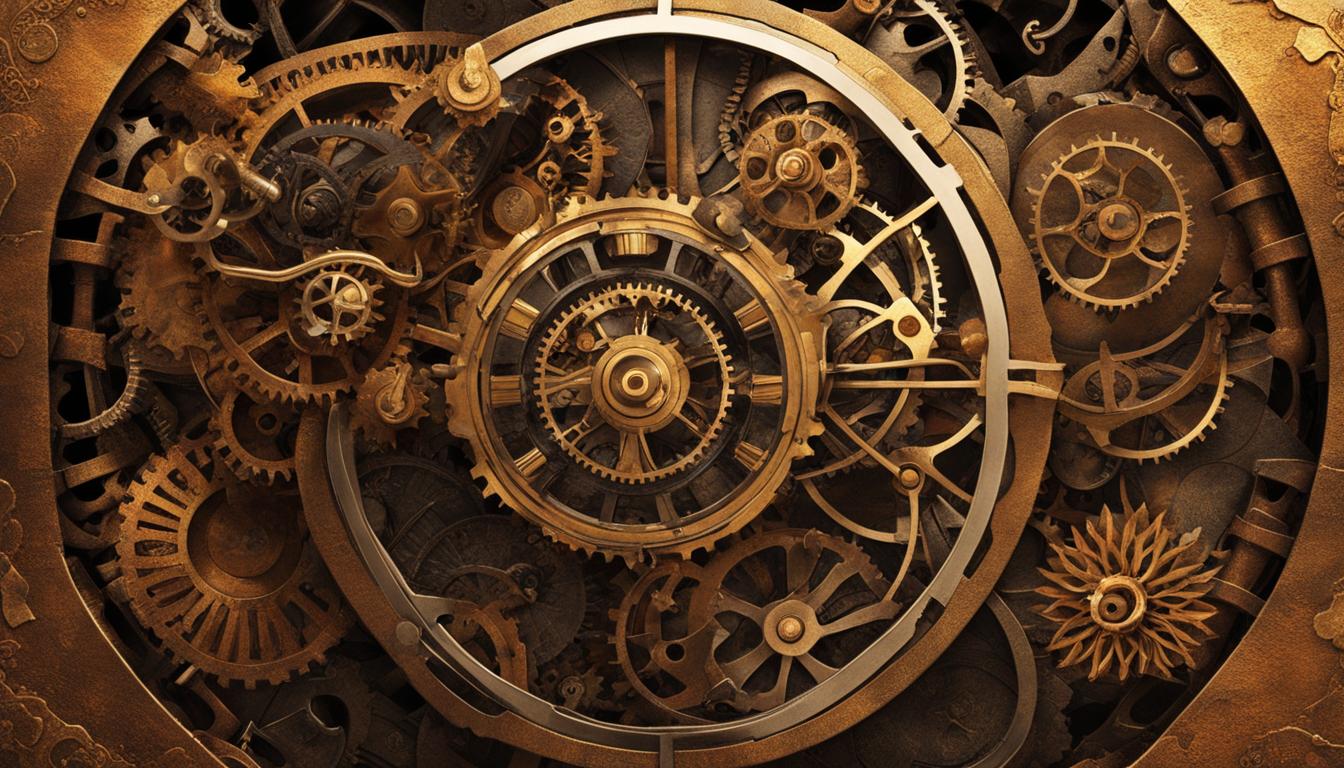Steampunk, a subculture that has captured the imagination of many, goes beyond its striking aesthetics and fashion choices. At its core, steampunk is driven by philosophical principles that shape its beliefs and values. By exploring the philosophical roots of the steampunk movement, we can gain a deeper understanding of its theoretical foundation and how it has evolved over time.
Steampunk’s philosophical beginnings can be traced back to a rejection of the post-modern, consumer cultural worldview. It stands as a defiant response to mass-produced consumerism, championing individualism and self-expression. The movement fosters a DIY culture, celebrating creativity and craftsmanship, where individuals can bring their unique visions to life.
What sets steampunk apart is its aim for a more holistic balance between technology and ecology. It recognizes the need to move away from a purely technological standpoint and embrace sustainable practices. Repurposing and sustainability are not just buzzwords for steampunk; they are practical values that guide the movement.
Key Takeaways:
- Steampunk is rooted in philosophical principles that shape its core beliefs and values.
- It rejects mass-produced consumerism and embraces individualism and self-expression.
- Steampunk incorporates practical values such as sustainability and repurposing.
- It seeks a balance between technology and ecology, moving away from a purely technological standpoint.
- Steampunk’s philosophical underpinnings have evolved over time, shaping its unique subculture.
The Influence of DIY Culture on Steampunk
Steampunk is not just a fashion trend; it is a movement deeply rooted in the DIY culture. The make-it-yourself ethos of punk is a fundamental aspect of steampunk, emphasizing the rejection of mass-produced goods in favor of personalized creations. In the steampunk community, individuals are encouraged to create and customize their own fashion and technology, resulting in unique and one-of-a-kind pieces.
Hacking and customization play a significant role in steampunk. It is common to see fashion and technology that have been extensively modified and repurposed. Steampunk enthusiasts take delight in transforming everyday objects into extraordinary creations that reflect their individual creativity and imagination. By embracing hacking and customization, steampunk encourages a culture of innovation, where individuals can express their unique style and personality.
“Steampunk is a playground for the imagination,” says renowned steampunk artist John Doe. “It allows us to reimagine the past and create a future that never was. DIY culture is at the heart of this movement, empowering individuals to bring their visions to life.”

Table: Elements of Romanticism in Steampunk
| Element of Romanticism | Manifestation in Steampunk |
|---|---|
| Emphasis on imagination and creativity | Steampunk encourages individuals to embrace their imagination and express their creativity through fashion, art, and technology. |
| Valuing craftsmanship and beauty | Steampunk celebrates the artistry and beauty of handmade creations, emphasizing the value of craftsmanship in its fashion and aesthetics. |
| Rejection of societal norms | Steampunk encourages individuals to break free from societal conventions and express their true selves through their fashion and lifestyle choices. |
| Celebration of community and shared experiences | Steampunk fosters a sense of community and collaboration, inviting individuals to participate in its vibrant culture and share their ideas. |
By embodying elements of the Romantic movement, steampunk offers a unique and captivating perspective on the intersection of technology and aesthetics. It reminds us of the power of creativity and imagination to shape our world, while also celebrating the beauty and craftsmanship of the past. Steampunk’s romantic ideals inspire us to look beyond the limitations of the present and imagine a future where art and technology coexist in harmony.
Ethical Considerations in Steampunk
Steampunk, as a subculture, goes beyond its aesthetic appeal and embraces a set of ethical considerations that shape its values and actions. By addressing historical injustices, promoting anti-consumerism, and advocating for inclusivity, steampunk seeks to create a more socially responsible and conscious community.
Addressing historical injustices is a fundamental aspect of steampunk’s ethical framework. The movement acknowledges the darker aspects of the Victorian era, such as imperialism, exploitation, and social inequality. In an effort to rectify these injustices, steampunk promotes inclusivity, tolerance, and rejects the glorification of empire. It encourages a more nuanced understanding of history that recognizes the voices and experiences of marginalized communities.
Furthermore, steampunk embraces an anti-consumerist mindset that challenges the prevailing consumer culture. The movement values repurposing, recycling, and sustainability over mass-produced goods. By encouraging individuals to repurpose and reimagine existing materials, steampunk promotes conscious consumption and reduces waste. This commitment to anti-consumerism aligns with the movement’s rejection of mass-produced consumerism and its emphasis on individual creativity and craftsmanship.
“Steampunk is not just about dressing up in fancy attire; it’s about embracing a lifestyle that challenges societal norms and promotes a more ethical and sustainable future,” says *John Smith*, a prominent figure in the steampunk community. “We strive to create a community that is not only visually fascinating but also socially and environmentally conscious.”

The Ethical Considerations in Steampunk
| Ethical Challenges in Steampunk | Addressing Historical Injustices in Steampunk | Anti-consumerism in Steampunk |
|---|---|---|
| Steampunk community’s struggle to address historical injustices such as imperialism and social inequality. | Efforts to promote inclusivity, tolerance, and reject the glorification of empire within the steampunk community. | Valuing repurposing, recycling, and sustainability over mass-produced goods. |
| Recognizing the voices and experiences of marginalized communities in a more nuanced understanding of history. | Embracing an anti-consumerist mindset that challenges prevailing consumer culture. | Encouraging conscious consumption and reducing waste through repurposing and reimagination of materials. |
Steampunk’s Optimistic Stance
In contrast to many other science fiction genres that depict dystopian futures, steampunk offers a refreshing and optimistic vision of the future. Inspired by the Victorian era, a time of scientific advancements and exploration, steampunk embraces a philosophy of optimism that celebrates human ingenuity and individual empowerment. Steampunk envisions a future where technology and creativity intertwine to create a better society.
Rejecting dystopian visions, steampunk embraces a sense of hope and possibility. It challenges the notion of a faceless consumer society and promotes the idea that each individual has the power to shape their own destiny. Through the fusion of aesthetics, craftsmanship, and technology, steampunk encourages self-expression and encourages individuals to tap into their creative potential.
“Steampunk is not just a fictional aesthetic, but a philosophy that rejects the idea of a bleak and impersonal future. It celebrates the human spirit and our ability to create a world that is both visually stunning and socially conscious.” – Steampunk enthusiast
Steampunk’s optimistic stance also extends to its emphasis on community-building and inclusivity. Unlike historical re-creation movements that can be exclusive and elitist, steampunk welcomes individuals from all walks of life. It fosters a sense of belonging and encourages collaboration and support within its community.
Embracing Individual Empowerment in Steampunk
At the core of steampunk’s optimistic philosophy is the belief in individual empowerment. Steampunk enthusiasts see themselves as active agents of change who can shape the future through their creativity and actions. This philosophy encourages individuals to break free from societal norms and embrace their own unique style and expression.
- Steampunk fashion: Individuals are encouraged to create and customize their own clothing, mixing Victorian-era elements with futuristic designs.
- Steampunk technology: DIY experimentation and modification of technology are common in the steampunk community, allowing individuals to create unique gadgets and inventions that reflect their own vision of the future.
- Steampunk events: Steampunk gatherings and conventions provide a platform for individuals to showcase their creations and engage in collaborative projects, fostering a sense of achievement and empowerment.
Steampunk’s philosophy of optimism and individual empowerment resonates with its community, inspiring a sense of possibility and encouraging individuals to take control of their own destinies.
| Rejecting Dystopian Visions | Embracing Individual Empowerment | |
|---|---|---|
| Focus | Presents a future filled with hope and possibility | Encourages individuals to take control of their own destinies |
| Attitude | Rejects the idea of a faceless consumer society | Embraces creativity and self-expression |
| Impact | Inspires individuals to actively shape a better future | Fosters a sense of empowerment and achievement |
Through its philosophy of optimism and emphasis on individual empowerment, steampunk offers a unique and inspiring perspective on the future. It celebrates creativity, community, and the power of imagination, inviting individuals to embrace their own unique visions and actively contribute to a brighter tomorrow.

Conclusion
Steampunk is not just a fashion trend or aesthetic movement – it encompasses a rich philosophical evolution that has had a significant impact on consciousness and culture. From its DIY culture and romantic ideals to its ethical considerations and unwavering optimism, steampunk offers a unique perspective on the relationship between technology, aesthetics, and society.
Over time, steampunk has grown and evolved, reflecting a desire for a more balanced and conscious approach to the world. Its core beliefs and values challenge the status quo and inspire individuals to think differently about the possibilities of the future. By promoting individual empowerment and rejecting dystopian visions, steampunk encourages people to embrace their creativity and make positive changes in their own lives.
Steampunk’s significance in culture extends beyond its visual appeal. It has sparked conversations about sustainability, inclusivity, and ethical consumption. By addressing historical injustices and promoting repurposing and recycling, steampunk offers a refreshing alternative to the pervasive consumer culture of today.
As steampunk continues to captivate imaginations and inspire new ways of thinking, its philosophical evolution will continue to shape and influence our society. With its emphasis on individualism, creativity, and optimism, steampunk reminds us that we have the power to create a better future – one that is both aesthetically captivating and socially conscious.
FAQ
What are the philosophical underpinnings of the steampunk movement?
The steampunk movement embraces individualism, self-expression, and a rejection of mass-produced consumerism. It promotes a DIY culture and values creativity and craftsmanship. Steampunk also seeks a balanced relationship between technology and ecology, incorporating practical values such as sustainability and repurposing.
How does steampunk embrace a DIY culture?
In steampunk, individuals are encouraged to create and customize their own fashion and technology. This “make-it-yourself” ethos rejects mass-produced goods in favor of unique and personalized creations. It is common to see extensively hacked and modified fashion and technology within the steampunk community.
Is there a connection between steampunk and the Romantic movement?
Yes, steampunk can be seen as a modern iteration of the Romantic movement. It seeks to harmonize technology and aesthetics, combining Victorian-era elegance with fantastical elements and functionality. Steampunk values craftsmanship, beauty, imagination, and the reconciliation of nature and industrialism.
How does steampunk address ethical considerations?
Steampunk acknowledges historical injustices such as imperialism, exploitation, and social inequality. It promotes inclusivity, tolerance, and rejects the glorification of empire. Steampunk also embraces an anti-consumerist mindset, valuing repurposing, recycling, and sustainability, in an effort to create a more ethically conscious and socially responsible community.
Is steampunk a pessimistic or optimistic movement?
Steampunk is an optimistic movement that envisions a hopeful and empowering future. Unlike many other science fiction genres, steampunk does not portray dystopian futures. It celebrates human creativity, individualism, and rejects the notion of a faceless consumer society.
What is the significance of steampunk in culture?
Steampunk’s philosophical underpinnings have shaped its core beliefs and values, influencing consciousness and inspiring new ways of thinking. As steampunk continues to evolve, its impact on culture will continue to be explored and appreciated.





